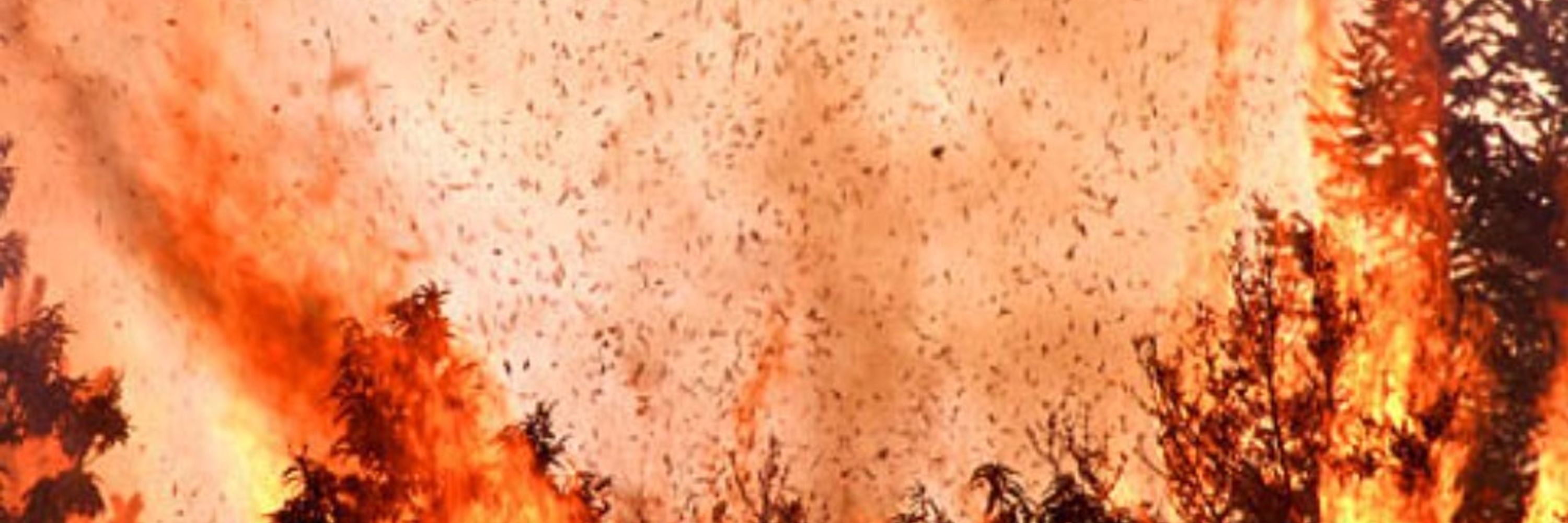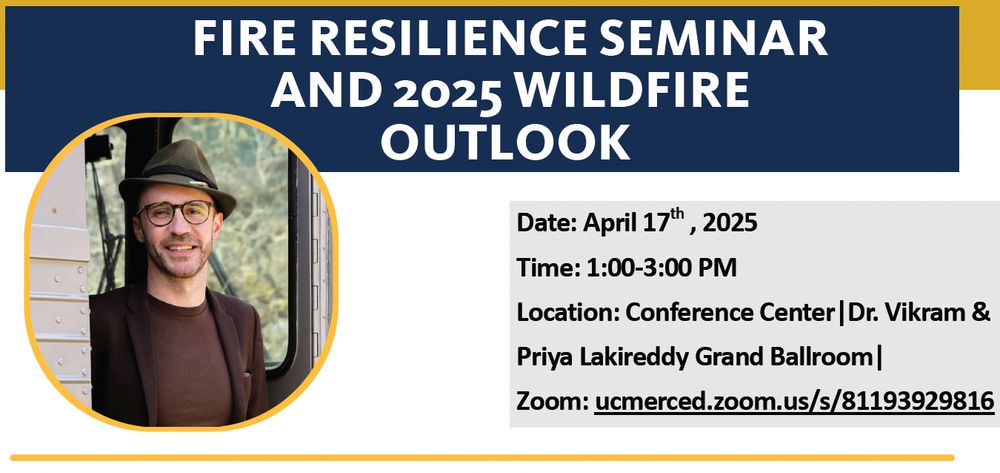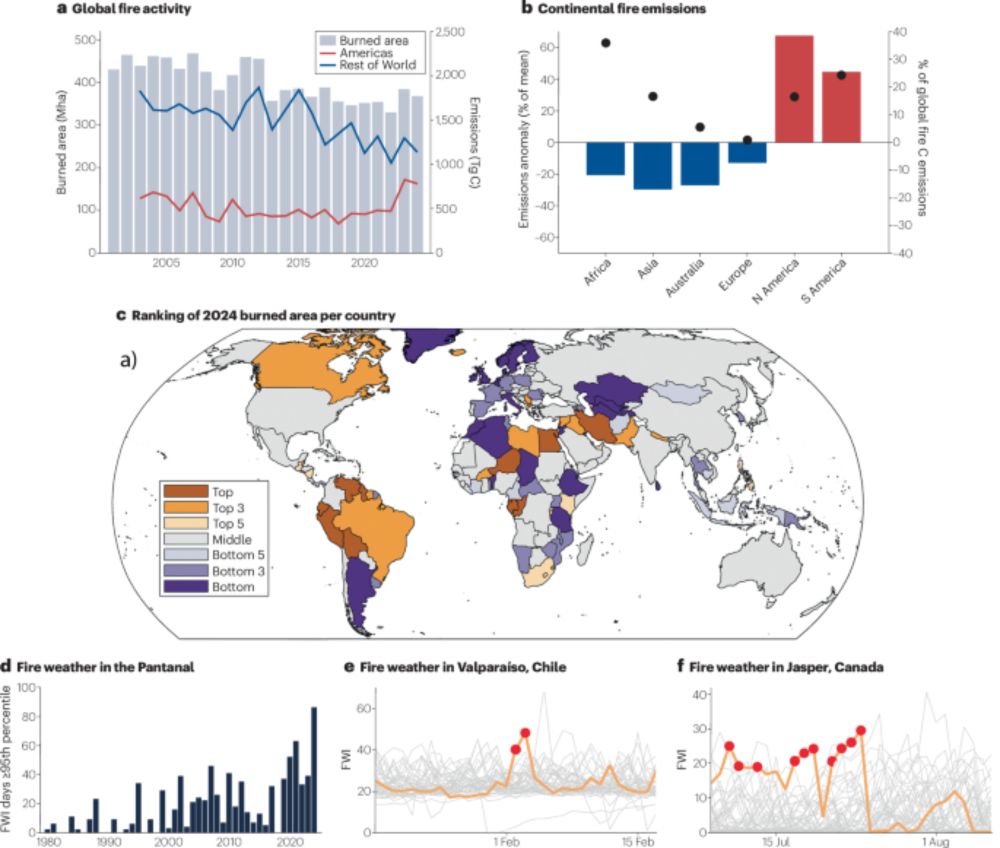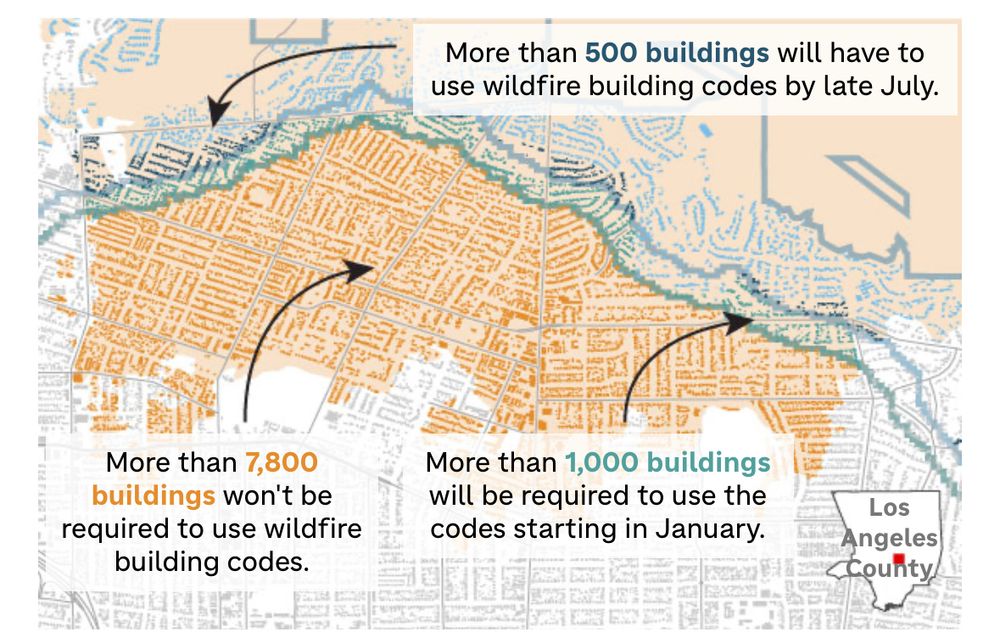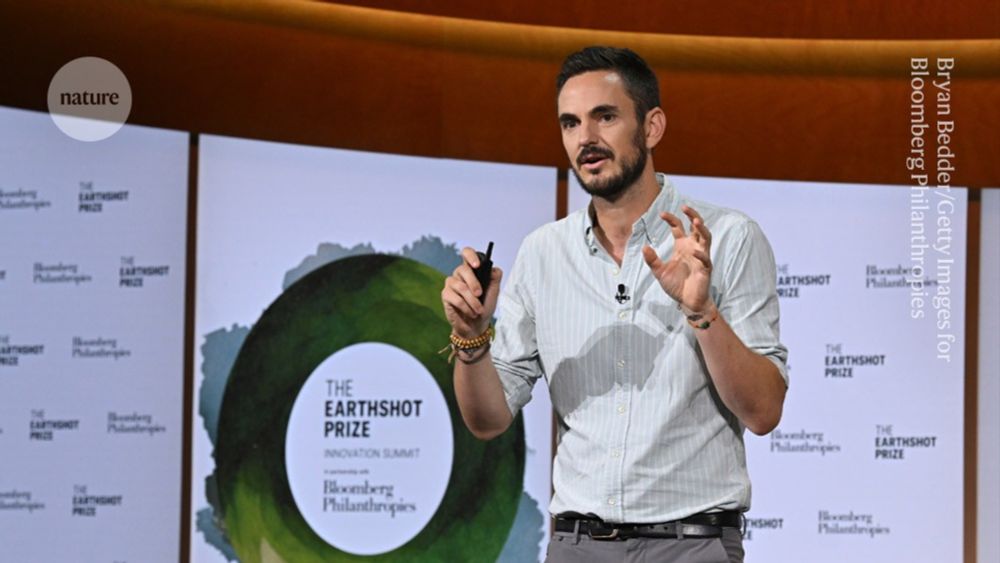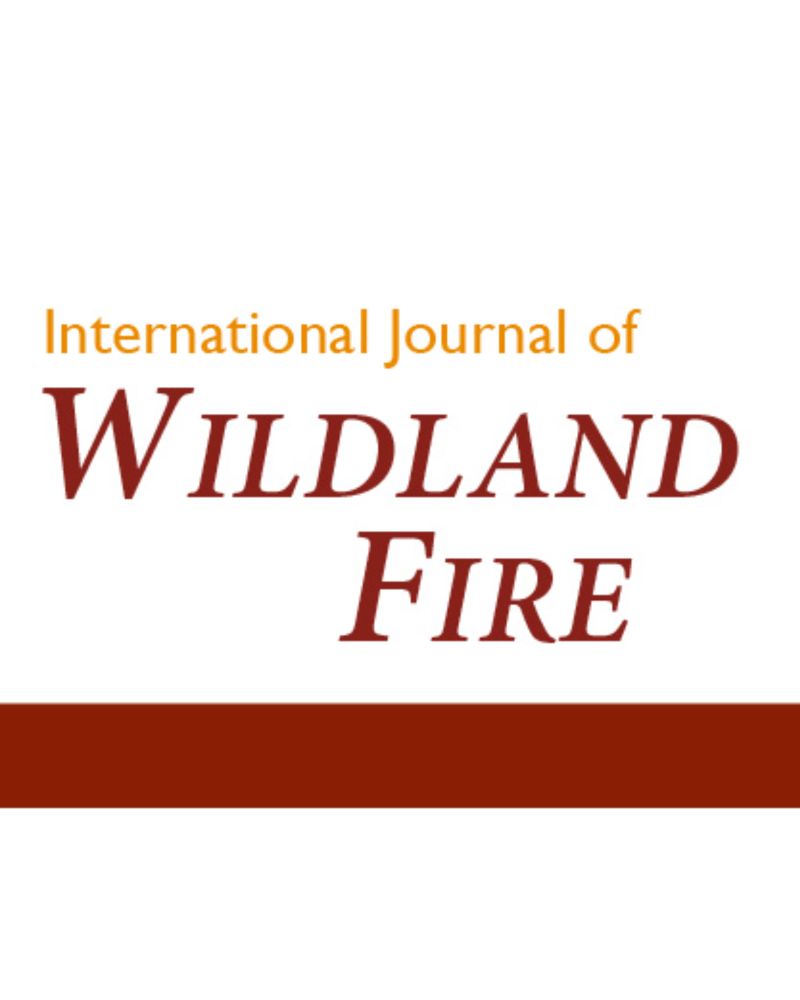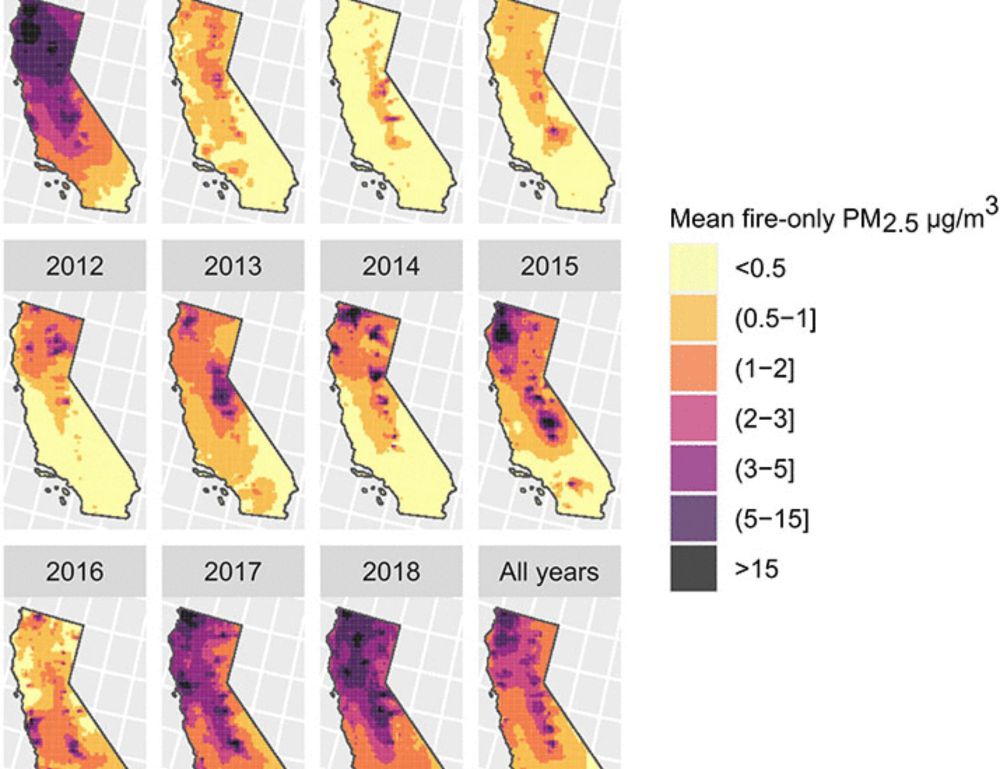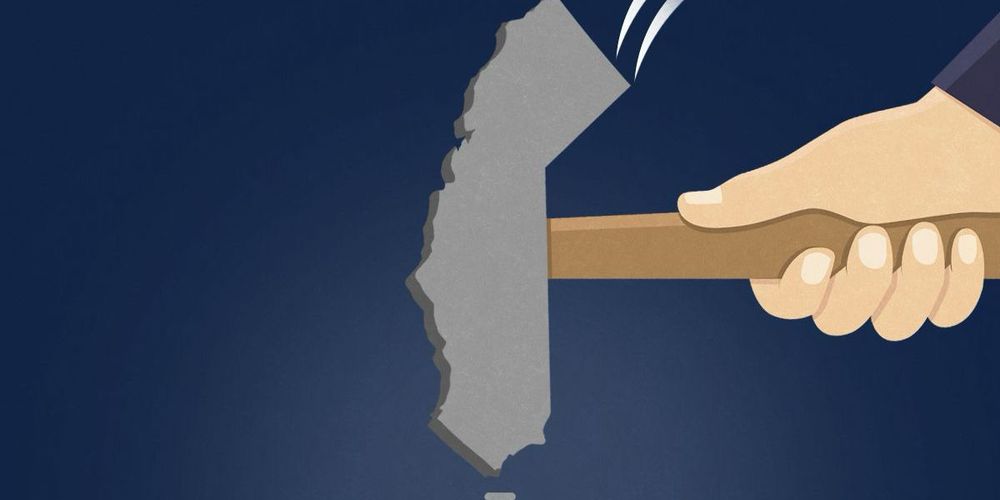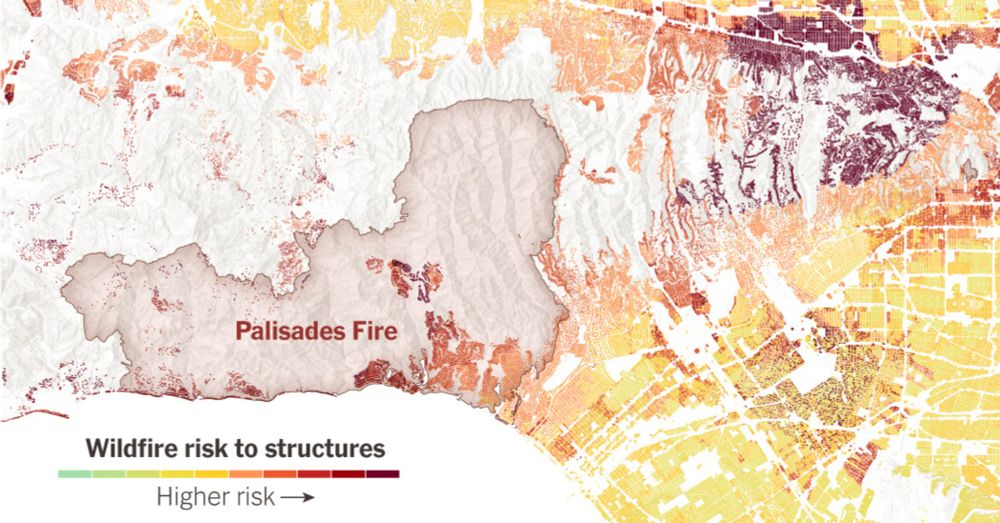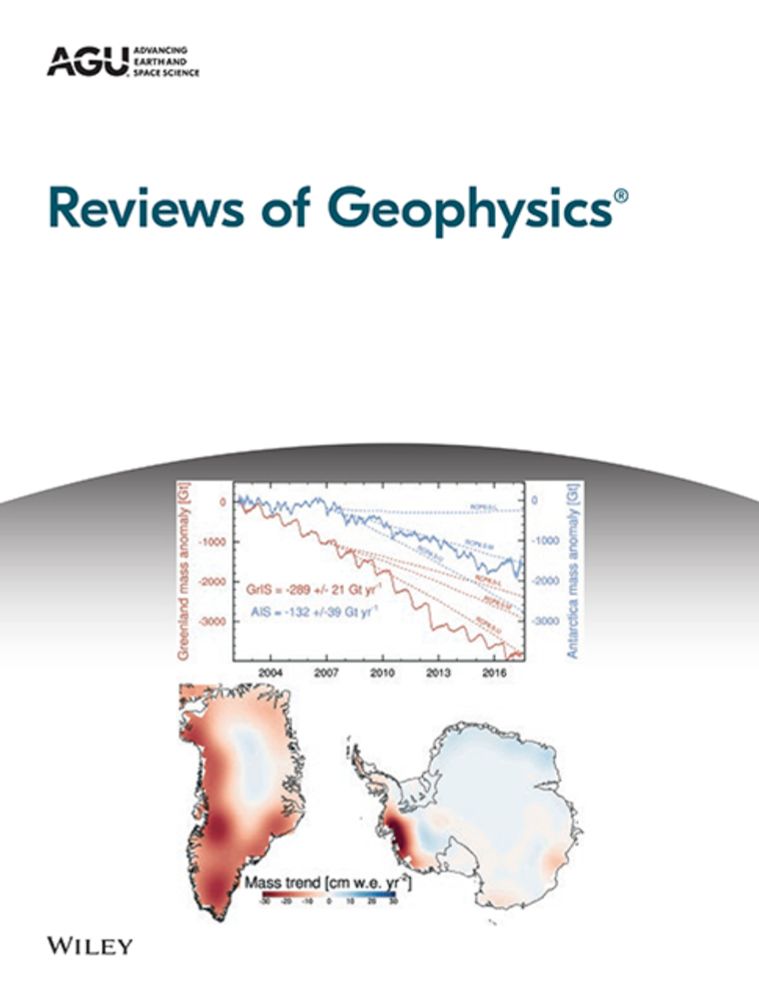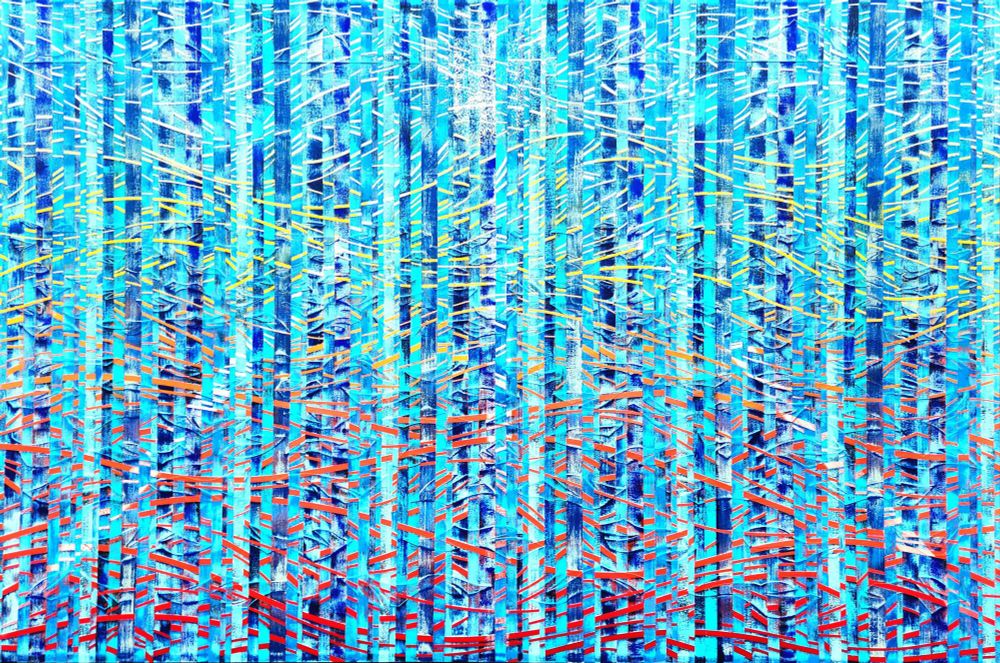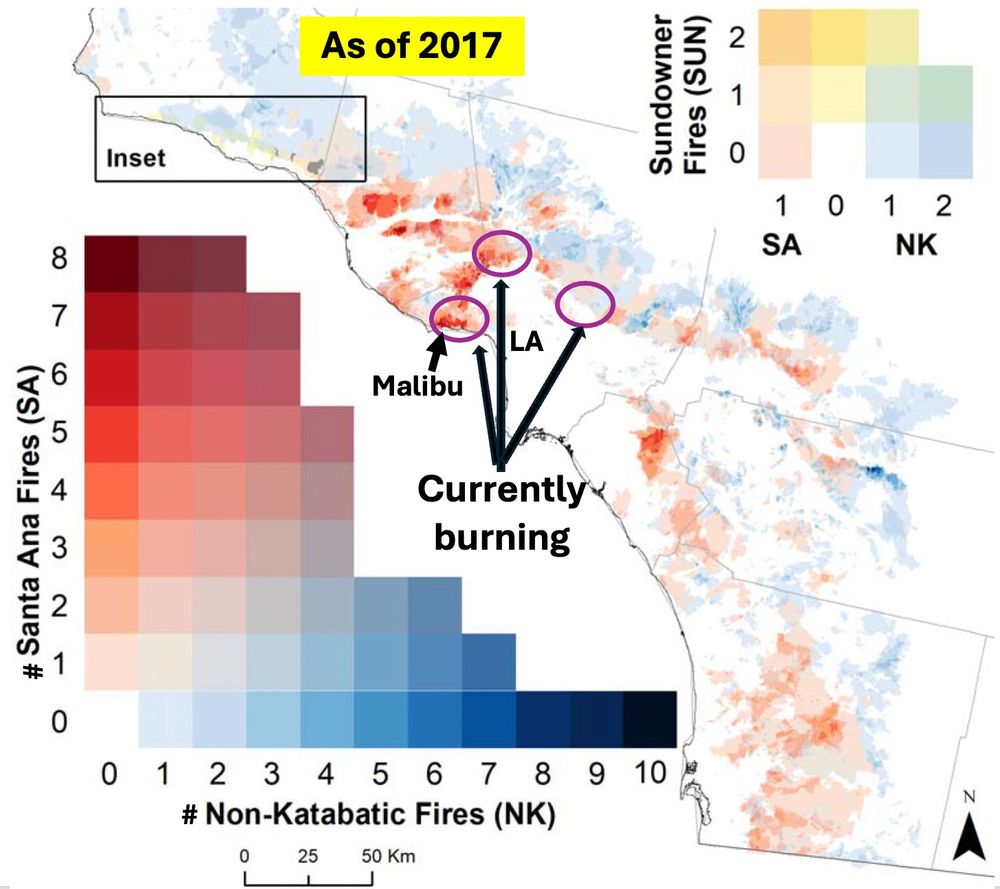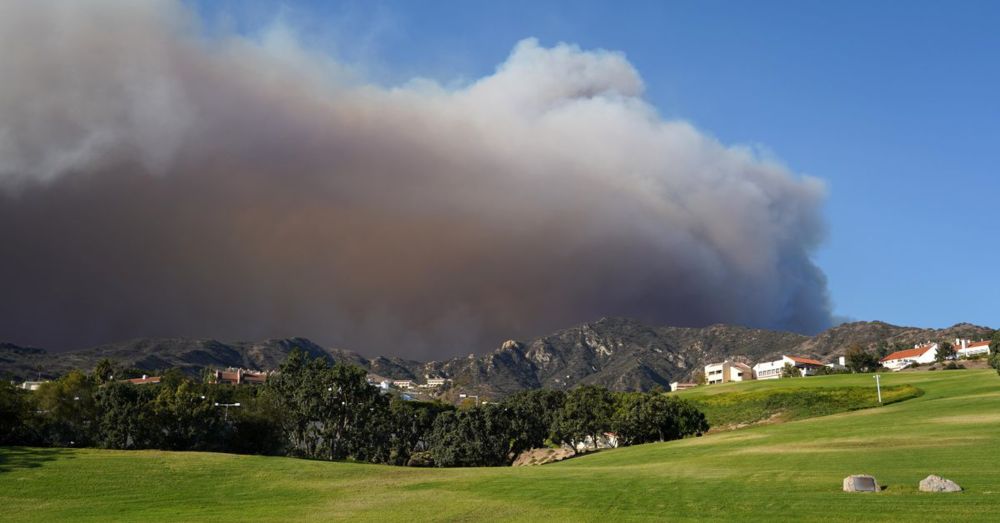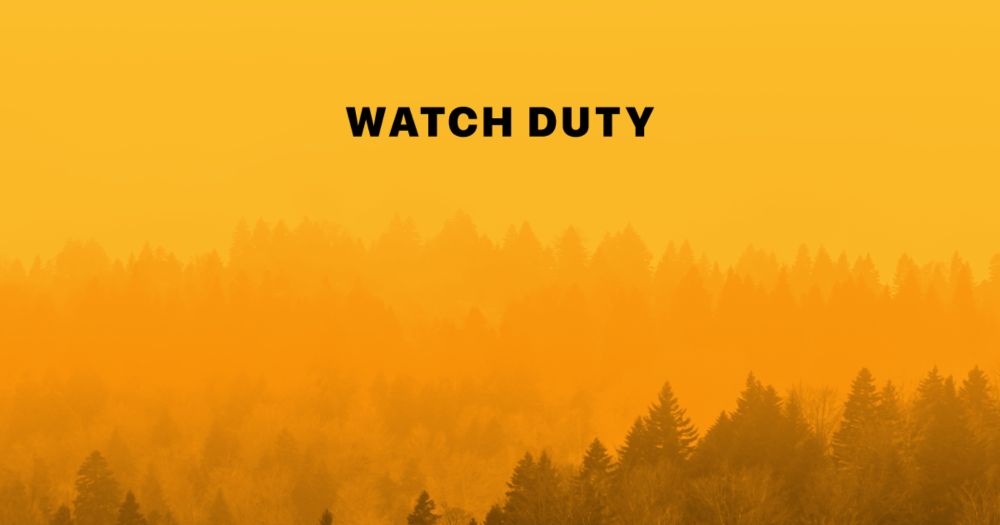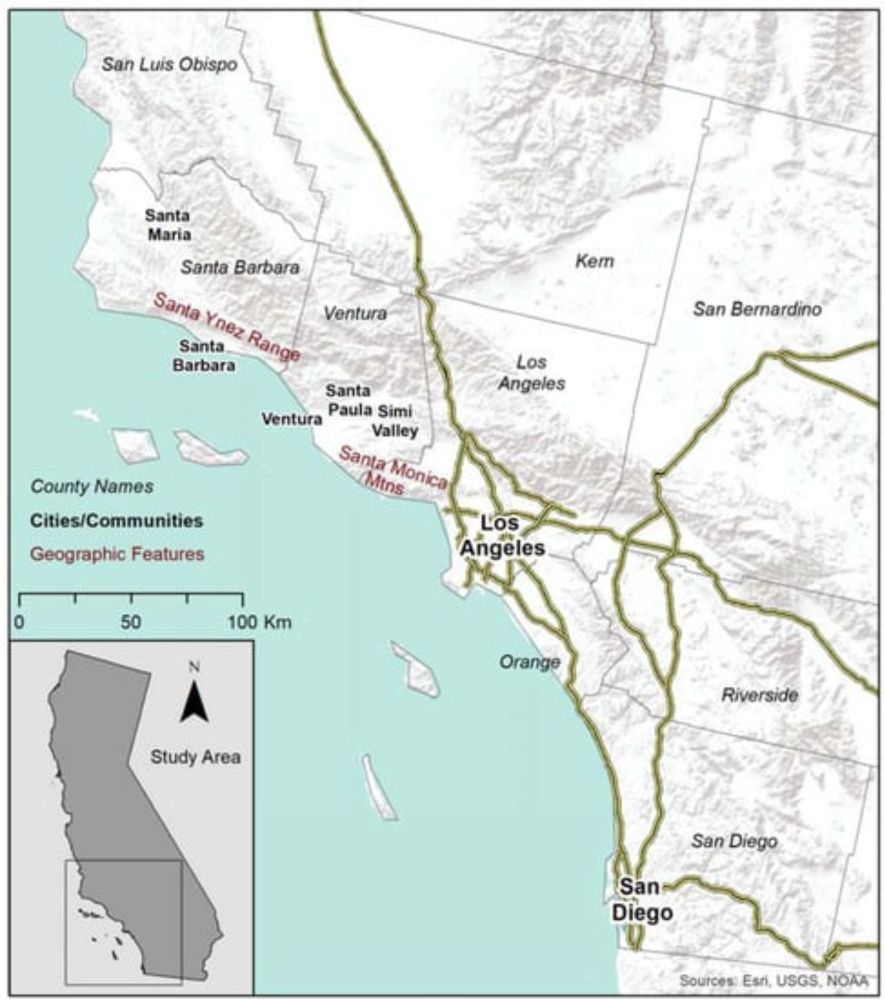Dr. Crystal A. Kolden
Director, UC Merced Fire Resilience Center. Pyrogeographer. I study wildfire in the era of anthropogenic climate change. Former wildland firefighter. Opinions are my own. *she/her* 🔥🔥🔥
- [Not loaded yet]
- Thanks for taking pictures, Asmeret
- TOMORROW! There's still time to register: 1pm - Introductions and talk by John Mills of @watchduty.org 2pm - A look ahead at the 2025 Fire Season in CA with @climate-guy.bsky.social 2:15pm - Mitigating smoke with Dr. Sandie Ha 2:30pm - Q&A with all speakers MEDIA is welcome. Please join us!
- On 4/17 @ucmerced.bsky.social Fire Resilience Center will host John Mills, CEO and co-founder of @watchduty.org AND have discussion with @climate-guy.bsky.social and Dr. Sandie Ha on: 1) The upcoming fire season in CA 2) How you can prepare, esp. for smoke We're streaming it online - join us!
- Climate change continued to have unpredictable impacts on wildfire in 2024. Unexpected shifts, like the Americas producing 40% of C emissions (normally it's <25%), and anomalous events, like the fatal Feb '24 Chile fire or the Pantanal wetlands burning, occur more often.
- Kolden et al. document 2024 wildfires, finding: - 367 Mha burned - Burned area decreased 5.4% from 2023 - Fires released an estimate 1965 Tg C www.nature.com/articles/s43... (rdcu.be/ehnTP) @pyrogeog.bsky.social @climate-guy.bsky.social @mattwjones.bsky.social @ueaenv.bsky.social [6/n]
- On 4/17 @ucmerced.bsky.social Fire Resilience Center will host John Mills, CEO and co-founder of @watchduty.org AND have discussion with @climate-guy.bsky.social and Dr. Sandie Ha on: 1) The upcoming fire season in CA 2) How you can prepare, esp. for smoke We're streaming it online - join us!
- This is your regular reminder that ALL buildings in California must build to seismic codes, but only those in CALFIRE's designated high hazard areas must build to WUI fire codes. Why the discrepancy? Who the hell knows...but it means the cycle of rebuild and burn again will continue.
- California just released new maps on where homes have to be built with wildfire-resistant materials. But the majority of homes destroyed in the Eaton fire won’t have to use those building codes www.npr.org/2025/03/25/n...
- Ed Abbey words to live by: “A patriot must always be ready to defend his country against his government.” “Anarchism is founded on the observation that since few men are wise enough to rule themselves, even fewer are wise enough to rule others.” “Anarchism is democracy taken seriously.”
- Worried about wildfires this year? You should be. Preparedness is the absolutely most effective way to mitigate disasters, and the firing of thousands of employees and hiring freeze means that there is almost no one to prepare. WHEN wildfires start (not if), suppression will be a mess.
- "Training is preparation for the known; education is preparation for the unknown." Just remember that we train AI, but we educate humans.
- [Not loaded yet]
- Ironically called ICYMI
- There is a huge need for basic social support: driver (many people lose cars/transit), personal shopper, tech support (online forms for older people), babysitter (so parents can work/deal with crises), etc. Slightly more training: Disaster Case Manager (an advocate for survivors).
- 🔥 Fire peeps... @wildland-zko.bsky.social joined us. Give him a follow.
- @weatherwest.bsky.social I just set up an account here. Can you let your followers know I'm on here, now?
- I am shocked* that the Trillion Trees guy ends up being a problem dude. They won't comment, but anyone with that kind of funding record doesn't get let go without doing something VERY, VERY BAD. *Note: I am not shocked at all
- Someone who has brought in tens of millions of dollars and has 40 to 60 people in his group is obviously a big deal at any institution. So, for that institution to let him go says a lot. But another institution is just going to take him in and act like nothing happened? #AcademicChatter #AcademicSky
- [Not loaded yet]
- Hansen (2012) does the hard math looking at many variables, but here's the basic summary: an intense brushfire with average 8ft flames requires ~264,000 gallons/acre to extinguish. The top flow from a fire hydrant is 1,500 g/m. This is why we cut line. www.publish.csiro.au/wf/WF11022
- [Not loaded yet]
- You're too kind, Liz! Right back atcha.
- In Sept 2020, in the wake of a record CA fire season, I wrote an opinion piece for @nature.com about the need to focus on the human metrics of fire, not the acres burned. The #LAFires underscore that our obsession with size fails to convey the scope of the impacts. 🧵 www.nature.com/articles/d41....
-
View full threadNeither the Palisades nor the Eaton Fire is in the top 300 largest fires in CA historically. But their outsized catastrophic impacts demonstrate the importance of focusing on something other than area burned, which not only rules reporting, it still rules much of fire science & fire agency targets.
- Fire size is still important, particularly related to ecological impacts. But it's a terrible metric of accomplishments for fire agencies. We don't want to reduce acres burned, we want to reduce negative outcomes, and that's a very important difference.
- The effects of toxic smoke will play out for millions of Angelenos in the coming years. Research on wildfire smoke estimates that it causes tens of thousands of premature deaths, >4 orders of magnitude beyond the initial losses. www.science.org/doi/10.1126/...
- These fires have also scarred some of the most unstable geomorphology in the US. When the rains do come, they can create landslides and mudflows like the one that killed 23 people and damaged 500 homes in Montecito after the 2017 Thomas Fire. This secondary hazard requires preparation now.
- As @calfire.bsky.social updates their data, it shows up on maps here: #PalisadesFire: www.fire.ca.gov/incidents/20... #EatonFire: www.fire.ca.gov/incidents/20...
- Infrastructure losses are also substantial. Schools, churches, stores, health services, utilities and more provide critical community services that cannot be easily replaced. The ripple effect of losing these services is secondary negative impacts for tens of thousands.
- First, 24 people lost their lives. Most were older and/or mobility limited, consistent with civilian wildfire fatalities. For now, it is the 5th largest loss of civilian life in a firestorm event in the modern era after Lahaina 2023, Camp 2018, North Bay 2017, & Oakland Hills 1991.
- As of today, 16 January, @calfire.bsky.social DINS program has identified over 8,000 structures destroyed by the fires. Approximately 85% of these are homes. They still have thousands of structures to inspect. The final home loss from this event will likely be >10,000, 2nd only to Camp 2018 (13K+).
- An important facet of the fire building code discussion is that it only applies to areas that CALFIRE deems high fire hazard; it's not blanket. Many urban homes burned in recent years were't included. For seismic codes, every house in the state must comply no matter how far from a fault line.
- California’s 7A building code is the most robust in the country. Here’s why that didn’t stop the LA fires, from @zeitlin.bsky.social.
- [Not loaded yet]
- Great point. Unfortunately, those short-term economic choices clearly have long-term ramifications. Denying the risk of fire is wishful thinking in the pyrocene.
- [Not loaded yet]
- I feel seen.
- The @calfire.bsky.social DINS program is the best post-fire data collection program in the world. I wish every state would adopt this, we would learn so much more. Structure losses (so far) for #PalisadesFire: recovery.lacounty.gov/palisades-fi... For #EatonFire: recovery.lacounty.gov/eaton-fire/
- CAL FIRE’s Damage Inspection Teams (DINS) are on the ground in the Los Angeles area, assessing homes and properties impacted by recent fires. youtu.be/kI_nZwWONOE #LAFires
- To journalists who contact me last week and I wasn't able to respond...my sincere apologies. I lost my voice the week of the worst wildfire disaster ever in LA (didn't have that on my 2025 bingo card!). Many thanks to those of you asking the questions that help us become more resilient.
- Appreciate the opportunity to chat w/ @nytimes.com about how we can build smarter (and to code!!) after these wildfires. Suspending wildfire building codes only kicks the can down the road and invites another disaster. Hardened homes and defensible space for the win. www.nytimes.com/interactive/...
- Appreciate @marketplace.org having me on to talk about how we can live with wildfires. www.marketplace.org/shows/make-m...
- For the thousands of people asking "How do we fix this #wildfire problem?", @michaelwara.bsky.social wrote an excellent white paper 3 years ago that neatly lays out the basics of the multipronged approach. It still holds. @stanfordwoods.bsky.social hosted a discussion panel as well.
- [Not loaded yet]
- I can't remember if the panel was recorded, but if it was, post it and I'll repost. Seminars are basically podcasts run by people nerding out on science, right?
- It's a great synthesis of the challenges, the solutions, and concrete next steps. Important and highly useful work!
- [Not loaded yet]
- This is why my credentials are pinned to the top of my profile. I may not always be right, but I've got 25 years of experience and a PhD that says I know what I'm talking about most of the time. I'm amazed how many people online will believe someone who hides behind anonymity.
- Globally, we published a summary paper in 2022 that looks at fire and climate change globally, led by Matt Jones at UEA. agupubs.onlinelibrary.wiley.com/doi/full/10....
- If you're interested, you can find a summary of the latest research on wildfire and climate change in the US here: nca2023.globalchange.gov/chapter/2/
- Here's the reality about the #LAFires this week: this isn't the first time ANY of these places have burned. Not even close. In 2018, we mapped CA fire history to look at fire frequency across SoCal. Santa Monica Mtns area burns more than anywhere else -- up to once per decade in a given spot. 🧵
- [Not loaded yet]
- No, it actually does burn all at the same time. When Santa Anas happen in SoCal, it is almost always multiple fires simultaneously. See 2003 Firestorm, 2007 firestorm, etc. We humans just have very short memories.
- Many questions about whether people can/should live in Malibu. For answers, look at Pepperdine Univ. They safely sheltered-in-place just last month (Franklin Fire) and in 2018 (Woolsey Fire) thanks to excellent planning and fuel management. A model for getting it right. la.curbed.com/2018/11/20/1...
- [Not loaded yet]
- I'll be at UCLA next week, would be happy to discuss. None of the Syphard or Alexandre et al. paper looked at zone 0 as a variable because there was no data on it. @ibhs.org has done the science in their burn chamber to show it clearly matters, and I've seen enough burned communities to concur.
- I often use Watch Duty as an example of truly needed tech solutions for wildfire. Drones and AI are never going to prevent wildfires or put them out. But communications before, during, and after fire is a massive gap that tech can absolutely help solve.
- Pretty amazing that nonprofit Watch Duty -- which says it has 150 volunteers working around the clock to track wildfires -- has become the most trusted source of information on LA fires. Operated by retired/volunteer firefighters, dispatchers, and reporters. Real people. www.watchduty.org
- [Not loaded yet]
- Great question. Goats are best for here and most areas, bc they eat EVERYTHING, not picky. Nearly all for-rent grazers are goat herds, and many CA municipalities use them to clear public lands. But there isn't much of a market for goat meat, so the economics are challenging.
- I also know that you are working hard to rebuild your communities to be stronger and more fire resilient. And I have hope for a day when wildfire is something we plan and prepare for effectively, managing our homes, properties, and natural lands not to prevent fires, but to prevent fire disasters.
- Finally, many scientific papers on this topic, but the paper I reference at the top of this thread is here. END www.mdpi.com/2571-6255/1/...
- I know two things to be true: 1) People will rebuild here because they want to live in this magical place, and 2) these places will see fire again. I have no doubt. But I also know that you can rebuild and manage the land so that next time the houses won't burn down. I've seen it work.
- I am so sorry to everyone who has lost their home or been traumatized by these fires or any other wildfire disaster. I've interviewed many of you over the years, and I know how your life becomes defined by this awful event. I'm so grateful when you share your stories to help us learn.
- We also know much more about defensible space now. CALFIRE's new Zone 0 (0-5' from edge of house) is HUGE for reducing ember buildup next to the home. If every house is built to the highest WUI, and every homeowner actually follows defensible space guides, these disasters have different outcomes.
- There are so many natural disasters we can't prevent. Tornadoes, earthquakes, hurricanes, floods. But fires require fuel, and humans can manage fuel: the landscape, the homes, the property. It takes money, willpower, and the ability and desire to work together to address complex problems.
- Why am I making this point? Because as usual, the discussion over "letting people live in high fire risk areas" has begun. It's my job to point out that people have lived here for millennia, and because they knew the fire risk, they managed the fuel. Limited fuel = limited fire.
- Building codes matter. All of SoCal lives on the San Andreas fault, but we have earthquake building codes that mitigate potential losses. WUI building codes only went into effect in CA in 2007, so older homes were not built to resist fire. New homes are much more resistant thanks to better science.
- The county and state know this area has high fire risk, and they've done several veg reduction projects in recent years to try and address it. But prescribed fire is almost impossible to do here bc of complexity, manual labor is expensive, and there are numerous restrictions in conservation areas.
- This is not a forest. You can't just rake the leaves. It's a shrubland that used to be a lot more grassland when it was burned by the original Indigenous people and grazed during the ranching era. With climate change, increasing drought that intersects with Santa Ana winds is the recipe for fire.
